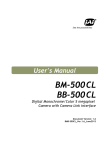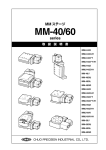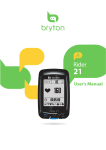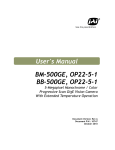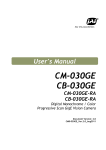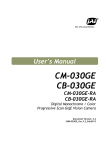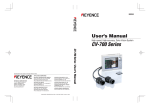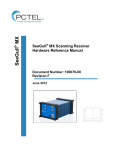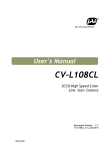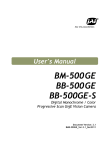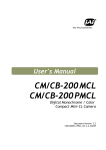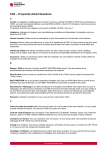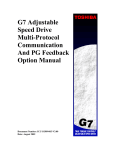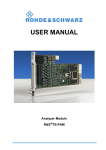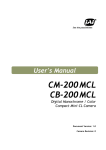Download BM-500CL, OP22-5-1 BB-500CL, OP22-5-1 User`s Manual
Transcript
User's Manual BM-500CL, OP22-5-1 BB-500CL, OP22-5-1 5-Megapixel Monochrome / Color Progressive Scan Camera Link Camera With Extended Temperature Operation Document Version: Rev A Document P/N: 10746 October 2010 BM-500CL, OP22-5-1 / BB-500CL, OP22-5-1 Notice The material contained in this manual consists of information that is proprietary to JAI Ltd., Japan and may only be used by the purchasers of the product. JAI Ltd., Japan makes no warranty for the use of its product and assumes no responsibility for any errors which may appear or for damages resulting from the use of the information contained herein. JAI Ltd., Japan reserves the right to make changes without notice. Company and product names mentioned in this manual are trademarks or registered trademarks of their respective owners. Warranty For information about the warranty, please contact your factory representative. Certifications CE compliance As defined by the Directive 2004/108/EC of the European Parliament and of the Council, EMC (Electromagnetic compatibility), JAI Ltd., Japan declares that BM-500CL/BB-500CL complies with the following provisions applying to its standards. EN 61000-6-3 (Generic emission standard part 1) EN 61000-6-2 (Generic immunity standard part 1) FCC This equipment has been tested and found to comply with the limits for a Class B digital device, pursuant to Part 15 of the FCC Rules. These limits are designed to provide reasonable protection against harmful interference in a residential installation. This equipment generates, uses and can radiate radio frequency energy and, if not installed and used in accordance with the instructions, may cause harmful interference to radio communications. However, there is no guarantee that interference will not occur in a particular installation. If this equipment does cause harmful interference to radio or television reception, which can be determined by turning the equipment off and on, the user is encouraged to try to correct the interference by one or more of the following measures: - Reorient or relocate the receiving antenna. - Increase the separation between the equipment and receiver. - Connect the equipment into an outlet on a circuit different from that to which the receiver is connected. - Consult the dealer or an experienced radio/TV technician for help. Warning Changes or modifications to this unit not expressly approved by the party responsible for FCC compliance could void the user’s authority to operate the equipment. -1- BM-500CL, OP22-5-1 / BB-500CL, OP22-5-1 -2- BM-500CL, OP22-5-1 / BB-500CL, OP22-5-1 -3- BM-500CL, OP22-5-1 / BB-500CL, OP22-5-1 1. 2. 3. 4. 5. - Contents - General ................................................................................................... 6 Camera nomenclature .................................................................................. 6 Main Features ............................................................................................ 7 Locations and Functions................................................................................ 8 Pin Assignment .......................................................................................... 9 5.1. 12-pin Multi-connector (DC-IN/Trigger) .......................................................... 9 5.2. Digital Output Connector for Camera Link....................................................... 9 5.3. Input and output circuits ..........................................................................10 5.3.1. Iris video output ...........................................................................10 5.3.2. Trigger input ...............................................................................10 5.3.3. XEEN output ................................................................................10 5.3.4. Camera Link interface ....................................................................11 6. Functions and Operations .............................................................................12 6.1. Basic functions ......................................................................................12 6.1.1. Digital Video Output (Bit Allocation) ...................................................12 6.1.2. Electronic Shutter .........................................................................13 6.1.3. Continuous operation or triggered operation .........................................13 6.1.4. Iris video output. ..........................................................................13 6.1.5. Rear panel indicator. .....................................................................14 6.1.6. Auto-detect LVAL-sync / async accumulation.........................................14 6.1.7. Starting pixel - Bayer color mosaic .....................................................14 6.1.8. Partial Scanning ...........................................................................15 6.1.9. Vertical binning............................................................................15 6.1.10. Decimation readout (Draft) mode in vertical direction..............................16 6.2. Pre-process functions ..............................................................................17 6.2.1. Bayer White Balance ......................................................................17 6.2.2. L/R channel balance ......................................................................17 6.2.3. Automatic output level controls ........................................................17 6.2.4. Programmable Look-Up Table (LUT)....................................................17 6.2.5. Blemish compensation circuit ...........................................................18 6.3. Sensor Layout and timing..........................................................................19 6.3.1. CCD Sensor Layout ........................................................................19 6.3.2. Horizontal timing ..........................................................................20 6.3.3. Vertical timing .............................................................................20 6.3.4. Partial Scan ................................................................................21 6.3.5. Vertical Binning............................................................................22 6.3.6. Decimation readout (Draft) mode.......................................................23 6.4. Operation Modes ....................................................................................24 6.4.1. Continuous operation .....................................................................24 6.4.2. Pre-Select Trigger Mode ..................................................................24 6.4.3. Pulse Width Trigger Mode ................................................................26 6.5. Mode and function matrix. ........................................................................27 6.6. Extended temperature operation (-45 ºC to +65 ºC) ..........................................27 7. Configuring the Camera ...............................................................................28 7.1. DIP switch SW-800 ..................................................................................28 7.2. RS-232C control .....................................................................................28 7.3. Setting functions....................................................................................29 7.3.1. Bit allocation. BA=0, BA=1, BA=2.......................................................29 7.3.2. Partial scan. SC=0 through 4 / Draft mode SC=5......................................29 7.3.3. Variable (Programmable) Partial PRGP=0,1 , STL=2 to 2058, ETL = 2 to 2058...29 7.3.4. Vertical binning............................................................................29 7.3.5. Shutter mode. SM=0 and SM=1...........................................................29 -4- BM-500CL, OP22-5-1 / BB-500CL, OP22-5-1 7.3.6. Trigger input select. TI=0, TI=1. ........................................................29 7.3.7. Trigger polarity. TP=0, TP=1.............................................................30 7.3.8. Gain level. GA=-84 through +336........................................................30 7.3.9. Black level. BL=255 through BL=767 ....................................................30 7.4. Save and Load Functions. .........................................................................30 7.5. BM-500CL / BB-500CL command list .............................................................31 8. Camera Control Tool for BM-500CL/BB-500CL .....................................................35 8.1. Camera Control Tool Interface Software........................................................35 8.1.1. Camera Control Tool Bar .................................................................35 8.2. The About Window .................................................................................35 8.3. Communication Window ...........................................................................36 8.4. Camera Control Window ...........................................................................37 8.5. Look-Up Table (LUT) ...............................................................................38 8.6. Using the Camera Control Tool ...................................................................38 9. External Appearance and Dimensions ...............................................................39 10. Specifications ...........................................................................................40 10.1. Spectral response................................................................................40 10.2. Specification table ..............................................................................41 11. Appendix.....................................................................................................43 11.1. Precautions ...........................................................................................43 11.2. Typical Sensor Characteristics .....................................................................43 11.3. Caution when mounting a lens on the camera .................................................43 11.4. Caution when mounting the camera .............................................................44 11.5. Exportation ..........................................................................................44 11.6. References...........................................................................................44 Change History ..................................................................................................46 User's Record ....................................................................................................47 -5- BM-500CL, OP22-5-1 / BB-500CL, OP22-5-1 1. General This manual covers the digital monochrome progressive scan camera BM-500CL, OP22-5-1 and color progressive scan camera BB-500CL, OP22-5-1 The BM-500CL, OP22-5-1 is a monochrome progressive scan CCD camera and the BB-500CL, OP225-1 is the equivalent Bayer mosaic color progressive scan CCD camera. Both have 5-megapixel resolution, a “B Series” cube housing, a Camera Link digital interface, and have been certified for extended temperature operation in environments ranging from -40ºC to +65ºC. Both the monochrome version (BM-500CL, OP22-5-1) and the color version (BB-500CL, OP22-5-1) provide a frame rate of 15 frames/second at full resolution. Using vertical binning (BM-500CL, OP22-5-1 only), draft mode (BB-500CL, OP22-5-1 only), or partial scan, the camera can achieve faster frame rates. The 2/3" CCD (ICX625) with square pixels offers superb image quality. The high-speed shutter function and asynchronous random trigger mode allows the camera to capture high quality images of fast moving objects. The color version BB-500CL, OP22-5-1 incorporates a primary RGB Bayer mosaic filter on the CCD to output raw Bayer images. Host-based color interpolation is required to display or save color images. The camera features built-in white balance and dual-tap channel balancing, eliminating the need for performing these functions on the host-PC. The latest version of this manual can be downloaded from: www.jai.com The latest version of the Camera Control Tool for these cameras can be downloaded from: www.jai.com For camera revision history, please contact your local JAI distributor. 2. Camera nomenclature The standard camera composition consists of the camera main body and C-mount protection cap. The camera is available in the following versions: BM-500CL, OP22-5-1 Where B stands for "B-series” form factor, M stands for monochrome, 500 represents the resolution "5 million pixels", CL stands for "Camera Link" interface, and OP22-5-1 refers to the extended temperature capabilities. BB-500CL, OP22-5-1 Where B stands for "B-series” form factor, B stands for Bayer color output, 500 represents the resolution "5 million pixels", CL stands for "Camera Link" interface, and OP22-5-1 refers to the extended temperature capabilities. For simplicity, the remainder of this document will refer to the cameras without the OP22-5-1 suffix. -6- BM-500CL, OP22-5-1 / BB-500CL, OP22-5-1 3. Main Features • • • • • • • • • • • • • • • • • • • 5-megapixel digital video camera Certified for extended temperature operation (-40ºC to +65ºC) 2/3” progressive scan CCD Monochrome and Bayer mosaic color versions 2456 (h) x 2058 (v) resolution 3.45 µm square pixels 15 frames/second (dual-tap) with full resolution in continuous or triggered operation Increased frame rate with vertical binning (BM-500CL only), draft mode(BB-500CL only), and fixed or variable partial scan Preset and auto shutter modes provided Programmable exposure from 64µs to 66 ms in full frame scan Edge pre-select and pulse width control modes Exposure time from 64µs to 2 sec. using pulse width trigger mode One-push or preset white balance for BB-500CL Manual and automatic gain control Look Up Table (LUT) for gamma and knee settings Built-in blemish compensation circuit LVAL-synchronous/-asynchronous operation (auto-detect) Auto iris lens video output (can be selected by DIP switch) 12- or 10- or 8-bit Camera Link output Setup by Windows NT/2000/XP/Vista/7 via serial communication -7- BM-500CL, OP22-5-1 / BB-500CL, OP22-5-1 4. Locations and Functions ④ ⑤ POWER/ TRIG DC IN/ TRIG ⑥ DIGITAL I / O ① ② ③ 1 2 3 4 5 6 Lens mount CCD sensor 26-pin connector 12-pin connector LED Mounting holes C-mount (Note *1) 2/3 inch CCD sensor Camera Link Interface ( Note *2) DC+12V and trigger input Indication for power and trigger input M3 depth 5mm for tripod mount plate (Note *3) *1) Note: Rear protrusion on C-mount lens must be less than 10.0mm. *2) Note: When a Camera Link cable is connected to the camera, please do not excessively tighten screws by using a driver. The Camera Link receptacle on the camera might be damaged. For security, the strength to tighten screws is less than 0.291 Newton meter (Nm). Tightening by hand is sufficient in order to achieve this. *3) Note: The part number for the tripod adapter plate (with 1/4"-20 thread) is MP-41 (option). Fig. 1. Locations -8- BM-500CL, OP22-5-1 / BB-500CL, OP22-5-1 5. Pin Assignment 5.1. 12-pin Multi-connector (DC-IN/Trigger) Type: HR10A-10R-12PB-01 (Hirose) male. Use the part number HR10A-10P-12S for the cable side Fig. 2 Hirose 12-pin connector Pin no. 1 2 3 4 5 6 7 8 9 10 Signal GND +12 V DC input GND Iris video GND 11 12 +12V DC input GND Remarks Only for Continuous mode. TR=0 NC NC GND XEEN out Trigger in *1) TI=1 (or Camera Link TI=0). *2) *3) 75 ohm termination *1) XEEN output can be configured with complementary emitter follower circuit or open collector by internal switch setting. The default is the complementary emitter follower circuit. See chapter 5.3.3 for details. *2) Factory default is trigger via Camera Link *3) 75 ohm termination can be enabled by SW 800. See Chapter 7.1 5.2. Digital Output Connector for Camera Link Type: 26-pin MDR connector (3M 10226-1A10PL) Fig.3 26-Pin Camera Link Connector Pin No 1,14 2(-),15(+) 3(-),16(+) 4(-),17(+) 5(-),18(+) 6(-),19(+) 7(+),20(-) 8(-),21(+) 9(-),22(+) 10(+),23(-) 11,24 12,25 13,26 In/Out O O O O O I O I Name Shield TxOUT0 TxOUT1 TxOUT2 TxClk TxOUT3 RxD TxD CC1 (Trigger) N.C N.C N.C Shield -9- Note GND Data out Clock for CL Data out LVDS Serial Control Trigger IN GND BM-500CL, OP22-5-1 / BB-500CL, OP22-5-1 5.3. Input and output circuits In the following schematic diagrams the input and output circuits for video and timing signals are shown. 5.3.1. Iris video output This signal can be used for lens iris control in continuous mode. The signal for iris video output is taken from the video signal after the gain control. The signal is 0.7 Vpp (without sync) from 75 Ω without termination. +5V 0.1μ 2K2 IRIS Video Out 1K 1μ DAC Fig. 4. Iris video 5.3.2. Trigger input An external trigger input can be applied to pin 10 of the 12-pin Hirose connector (when the command TI=1 has been set). The input is AC coupled. To allow long pulses the input circuit is designed as a flip-flop circuit. The leading and trailing edges of the trigger pulse activate the circuit. The trigger polarity can be changed by TP=1. Trigger input level 4 V ± 2 V. Trigger can also be applied through the Camera Link connector, when the command TI=0 has been sent. +5V Trig input pin #10 15k 100n 75Ω 1k 68k SW302.1 GND 1n Fig. 5. Trigger input. 5.3.3. XEEN output XEEN is on pin 9 of the 12-pin Hirose connector. The output uses either a complementary emitter follower circuit or open-collector. The output of the complementary emitter follower circuit is ≥ 3 V. (No termination) When the open corrector output is used, the maximum current is 120mA. However, if the current is more than 50mA, use thicker cable for connecting pins #8 and #9. If a thinner cable is used, it might cause a malfunction due to the resistance of the cable. The output can be selected by switch SW800 located inside the camera (rear board). Fig. 6. XEEN output EEN is also found in Camera Link. - 10 - TTL 100k 1k GND BM-500CL, OP22-5-1 / BB-500CL, OP22-5-1 5.3.4. Camera Link interface The digital video is available via Camera Link, with 8-, 10- or 12-bit pixel depth, using the CL Base configuration. The digital output signals follow the Camera Link standard using Channel Link chip sets. The data bits from the digital video, FVAL, LVAL, DVAL and EEN are multiplexed into the twisted pairs, which are a part of Camera Link. Trigger signals and the serial camera control are fed directly through its own pairs. The 26-pin MDR Camera Link connector pin assignment follows the Camera Link Base configuration. For a detailed description of the Camera Link standard, please refer to the Camera Link standard specifications found at the AIA web site, www.machinevisiononline.org. - 11 - BM-500CL, OP22-5-1 / BB-500CL, OP22-5-1 6. Functions and Operations 6.1. Basic functions The BM-500CL/BB-500CL cameras are progressive scan cameras with 5-megapixel monochrome or Bayer mosaic color CCDs. The interface to the host PC is via digital Camera Link. Both models can output video as 8-, 10- or 12-bit Camera Link data. The BB-500CL outputs raw Bayer video, requiring host-based color interpolation. The cameras also feature several pre-processing functions (see chapter 6.2) An analog iris-video signal can be used for controlling the iris of an auto-iris lens when operating in continuous mode. The cameras have both variable partial scan (user programmable) or fixed 2/3, 1/2, 1/4 and 1/8 image height scanning. Vertical binning (BM-500CL only) and decimation readout (BB-500CL) are also available for faster frame rates. There are 2 trigger modes in addition to continuous operation. The Pre-Select and Pulse Width trigger modes are available with a unique automatic LVAL sync or async selection function. The functions are described in detail in the following sections. 6.1.1. Digital Video Output (Bit Allocation) The 10-bit digital output is set at 890 LSB as 100% video level when CCD output is 200mV. The white clip level is set at 1023 LSB when CCD output is 230mV. CCD out Analogue level Black 200mV 230mV↑ Setup 3.6%, 25mV 700mV 800mV 8 bits 8 LSB 222 LSB 255 LSB Digital Out 10 bits 32 LSB 890 LSB 1023 LSB Fig.7. Digital Output Bit Allocation (in case of 10 bits ) - 12 - 12 bits 128 LSB 3560 LSB 4095 LSB BM-500CL, OP22-5-1 / BB-500CL, OP22-5-1 6.1.2. Electronic Shutter The BM/BB-500CL allows selecting shutter speed in two ways; preset shutter (10 fixed steps) and programmable exposure (in 2072 line-period LVAL increments). Preset Shutter (SH) The following shutter speeds can be selected by command SH=0 through SH=10. OFF (1/15), 1/30, 1/60, 1/100, 1/250, 1/500, 1/1000, 1/2000, 1/4000, 1/8000, 1/10000 seconds Programmable Exposure (PE) The exposure time can be programmed in 32.067µs (LVAL period) increments. The range is from 2 LVAL to 2072 LVAL. Minimum exposure time 2L 32.067µs x 2(L) = 64.13 µs Maximum exposure time 2072 L 32.067µs x 2072 (L) ≈ 66.44 ms In binning mode: Minimum Exposure time 2L 42.067 µs x 2(L) = 84.13 µs Maximum exposure time 1029 L 42.067 µs x 1029 (L) ≈ 43.71 ms In draft mode Minimum exposure time 2L 102.066 µs x 2(L) = 204.132 µs Maximum exposure time 261 L 102.066 µs x 261 (L) ≈ 26.64 ms Auto Shutter (ASC) The setting command is ASC. This command activates the auto shutter function. This function controls the shutter speed according to light changes and keeps the specified video level. Auto shutter controls from OFF (1/15) to 1/250 seconds. 6.1.3. Continuous operation or triggered operation The camera can operate in continuous operation for applications not requiring an asynchronous external trigger. This mode permits the use of a lens with a video-controlled iris. The camera will operate at its maximum frame rate, 15.05 frames/seconds in this mode. For applications that require an external trigger, the camera can accept an external trigger input on pin 10 of the 12-pin Hirose connector or via the Camera Link interface. The command "TI" is used to switch between inputs. The camera can operate at up to 15 frames/second in triggered operation. 6.1.4. Iris video output. The iris video output on pin 4 of the 12-pin Hirose connector outputs 700 mV when the video out in Camera Link is at the 100% level. The iris video signal is taken after the gain circuit. It is without sync. The iris video signal can be used to drive an auto iris lens in continuous mode. Fig. 8. Iris video output. - 13 - BM-500CL, OP22-5-1 / BB-500CL, OP22-5-1 6.1.5. Rear panel indicator. The rear panel mounted LED provides the following information: Amber: Power connected - initiating Steady green: Camera is operating in Continuous mode Flashing green: The camera is receiving external trigger POWER/ TRIG DC IN / TRIG DIGITAL I / O DIGITA 6.1.6. Auto-detect LVAL-sync / async accumulation This function replaces the manual setting found in older JAI cameras. Whether accumulation is synchronous or asynchronous in relationship to LVAL depends on the timing of the trigger input. When a trigger is received while FVAL is high (during readout), the camera works in LVALsynchronous mode, preventing reset feed-through in the video signal. There is a maximum jitter of one LVAL period from issuing a trigger to the start of accumulation. When a trigger is received during FVAL low, the camera works in LVAL-asynchronous mode (no delay mode). This applies to both Pre-Select (PS) trigger mode and Pulse Width (PW) trigger mode. External Trigger (1) (2) +/- 1 LVAL (3) FVAL (1) In this period camera executes trigger at next LVAL (prevents feed-through noise) (2) Avoid trigger at FVAL transition (+/- LVAL period), as the function may randomly switch between “ next LVAL ” and “ immediate ”. (3) In this period, camera executes trigger immediately ( no delay). Fig.9 Auto-detect LVAL sync/async accumulation 6.1.7. Starting pixel - Bayer color mosaic The BB-500CL is a color camera based on a CCD sensor with a Bayer color mosaic. The color image reconstruction is done in the host PC. The color sequence in the video signal is the same for any scanning modes except programmable partial scan. The right-hand drawing shows the color sequence at the image start. The starting line number is shown from LVAL. The first active pixel starts from LVAL, when DVAL rises. Even lines starts with GBG. Odd lines starts with RGR See also chapter 6.1.8 Partial Scan Fig. 10. Bayer color mosaic - 14 - BM-500CL, OP22-5-1 / BB-500CL, OP22-5-1 6.1.8. Partial Scanning The partial scanning function uses the middle of the image vertically to achieve a faster frame rate. This is effective for capturing and inspecting images which do not require the full height. The BM-500CL and BB-500CL have 4 fixed partial scan modes including 2/3, 1/2, 1/4 and 1/8. Variable Partial Scan Additionally, the BM-500CL/BB-500CL has a variable partial scan function. The start line and end line of the image can be set by the command STL and ETL. The command PRGP = 1 is used to activate this function. Line setting Command Parameter Start line STL = 2 to 2058 End line ETL = 2 to 2058 The effective read out lines can be calculated from the following formula. The End line – the Start line + 1 Frame rate calculation Frame rate ( fps ) = 1/ ( Total LVAL number of 1 frame x 32 µs ) Total LVAL number of 1 frame = FVAL LOW period + Upper Fast dump period + Normal read out period + Lower Fast dump period FVAL LOW = 4 ( lines) Upper Fast Dump period = + 2 ( lines ) Note) The first decimal place is rounded up. Normal read out = The End line – the Start line + 1 ( lines ) + 7 ( lines ) Lower Fast Dump period = Note) The first decimal place is rounded up. 6.1.9. Vertical binning This function is only available on the BM-500CL camera. Binning mode (Command VB) is a function where the signal charge from 2 adjacent (vertical) pixels are added together and read out as one pixel. Binning results in half vertical resolution and higher frame rate. By adding 2 pixels together, the sensitivity is doubled. The charge accumulated in 2 adjacent lines is added together in the - 15 - BM-500CL, OP22-5-1 / BB-500CL, OP22-5-1 horizontal CCD register. This is done by providing two pulses to the vertical CCD register for each line read out. Vertical binning can not be used together with partial scan. Fig. 11. Vertical Binning 6.1.10. Decimation readout (Draft) mode in vertical direction BB-500CL has a decimation readout (draft) mode. 4 lines of every 16 lines, 2 GB lines and 2 RG lines, are combined before being read out. When using this mode the field of view is maintained but the height of the image is reduced to 1/8 which is 261 lines. The frame rate is 37.54 frames per second. Fig.12. Draft mode - 16 - BM-500CL, OP22-5-1 / BB-500CL, OP22-5-1 6.2. Pre-process functions BM-500CL/BB-500CL has several pre-processing functions. The output from the camera is selectable to 8-, 10- or 12-bits but video is digitized to 14-bit internally. The pre-processing functions make use of the 14-bit video. Featured functions are: white balance (BB-500CL only), R/L channel balance, blemish compensation, gain control and LUT (Look Up Table) for gamma and knee correction. 6.2.1. Bayer White Balance Normally, the raw Bayer color signals are sent to the host as they are. In the host, the signals are interpolated to generate an RGB image and perform white balancing. In order to offload the host, the BB-500CL can adjust Gr, R , Gb and B levels individually to get the white balance for the Bayer output signal. White Balance Type Preset ( 3200K , 4600K , 5600K ) One–Push White Balance Manual White Balance Areas Setting AWBM=1 ( 3200), = 2 (4600), = 3 (5600 ) AWBM=0 ( One-push), AWB = 1 for activate ( 2600K to 6500K) Set by pixel gain ( R1/R2, GR1/GR2, B1/B2, GB1/GB2) Select 6 divided area for both L and R channels Note: Bayer white balance should be adjusted in continuous mode. 6.2.2. L/R channel balance The BM-500CL/BB-500CL has a dual-tap readout architecture with a Left (L) and Right (R) channel. In order to achieve the same gain and black level for both channels, the BM-500CL/BB-500CL has a built-in R/L channel balance function. The function is activated by a “one-push” software command. Channel Balance Type One-Push Gain (Auto White Level Adjust, AWA) One-Push Auto Black Level Adjust (ABA) Setting AWA=1 for activation ABA=1 for activation Note: 1. Channel balance adjustment should be done in continuous mode. 2. One-push channel balance should be done in the following order: ABA and then AWA. 6.2.3. Automatic output level controls These functions help to maintain a constant output level in accordance with ambient brightness changes. The two functions are AGC (Auto Gain Control) and ASC (Auto Shutter Control). AGC and ASC cannot be used at the same time. Functions Gain Mode (AGC) Auto Shutter Control (ASC) Setting AGC=0 ( Manual ) AGC = 1 ( AGC ON ) ASC= 0 ( OFF ) ASC = 1 ( ON ) Note: Only available in continuous mode. 6.2.4. Programmable Look-Up Table (LUT) BM-500CL/BB-500CL has a programmable look-up table (LUT) that lets the user adjust the transfer function of the video output. Selectable settings include multiple-point LUT and Gamma 0.45. - 17 - BM-500CL, OP22-5-1 / BB-500CL, OP22-5-1 The look up table has 256 setting points by which the full range of input signal is divided. On each of the points, the gain can be set to get the required transfer function. In the case of the BB500CL, Gr, R, Gb and B signals all have the same characteristics. Gamma 0.45 or programmable LUT can be selected by software control. If the LUT is not configured, Gamma is set at 1.0 (OFF). 6.2.5. Blemish compensation circuit BM-500CL/BB-500CL has a blemish compensation circuit. This function compensates for blemishes on the CCD sensor (typically pixels with extremely high response or extremely low response). This applies to both monochrome and color versions. Pixels that fulfill the blemish criteria can be compensated by pixels in both adjacent columns. The number of compensated pixels is up to 8 on both L and R channels. In case of BB-500CL, the defective pixels can be compensated by using the same Bayer color pixels in both adjacent columns. The compensation circuit can be enabled or disabled by software control. The factory default is OFF. - 18 - BM-500CL, OP22-5-1 / BB-500CL, OP22-5-1 6.3. Sensor Layout and timing 6.3.1. CCD Sensor Layout The CCD sensor layout, with respect to pixels and lines used in the timing and video full frame readout, is shown below. For Bayer color sequence, refer to chapter 6.1.7. 2 OB Active Pixel Output 2058 2456(H) x 2058(V) (1,1) 8 1 24 16 L Channel 1228 R channel 1228 Dummy OB 16 24 1 OB Dummy Fig. 13. CCD sensor layout - 19 - OB BM-500CL, OP22-5-1 / BB-500CL, OP22-5-1 6.3.2. Horizontal timing The LVAL period is shown for continuous mode. H-Timing FULL FRAME READ OUT / PATIAL READ OUT 1LVAL 1924ck = 32us 1ck= 16. 66ns LVAL DATA OUT OB Valid data OB 1228ck 40ck 1268ck 656ck 1228ck 696ck DVAL Fig. 14. Horizontal timing 6.3.3. Vertical timing The FVAL period for continuous mode full scan is shown. FULL FRAME READ OUT FRAME RATE 2072L 15.05fps LVAL 2072L FVAL 123 DAVL DATA 4L 8L OB 2056 2057 2058 2058L Valid data 2L OB OB 2L CCD Exposure EEN XEEN Fig. 15. Vertical timing for full scan - 20 - BM-500CL, OP22-5-1 / BB-500CL, OP22-5-1 6.3.4. Partial Scan Partial scan allows higher frame rates by reading out a smaller center portion of the image. This is particularly useful when inspecting objects that do not fill the whole height of the image. Fast-dump period Normal scan period Fast-dump period Full scan Partial scan Vertical Timing The diagram and table below provide vertical timing information for the fixed partial scan settings of 2/3, 1/2, 1/4, and 1/8. PATIAL FRAME READ OUT LVAL FVAL DAVL 4L DATA Valid data CCD Exposure 2L EEN XEEN A B C Values for vertical timing in partial scan continuous mode. C Total line frame rate B (L) FVAL Low A AREA (L) (L) (L) (L) (L) Start line End line 1030 1/2 4 176 93 L 1303 L 23.93 515 1544 514 1/4 4 262 136 L 918 L 34.04 773 1286 258 1/8 4 304 158 L 724 L 43.07 901 1158 1374 2/3 4 118 65 L 1561 L 19.97 343 1716 Remark! The color sequence for BB-500CL differs in partial scan. Refer to chapter 6.1.7. Fig. 16. Vertical timing for partial scanning - 21 - BM-500CL, OP22-5-1 / BB-500CL, OP22-5-1 Horizontal Timing The horizontal timing is the same as for full scanning. H-Timing FULL FRAME READOUT / PARTIAL READOUT Fig. 17. Horizontal timing for partial scanning 6.3.5. Vertical Binning Vertical binning combines charge from two adjacent lines, reducing the vertical resolution to half and at the same time increasing frame rate and sensitivity. By activating this function, the frame rate is increased to 22.88 fps. This function is available only for BM-500CL. Vertical binning can not be used together with partial scanning. Horizontal Timing H-Timing V binning Fig. 18. Horizontal timing for vertical binning - 22 - BM-500CL, OP22-5-1 / BB-500CL, OP22-5-1 Vertical Timing V binning FRAME RATE 1039L (1029L active) @ 22.88 fps Fig. 19. Vertical timing for vertical binning 6.3.6. Decimation readout (Draft) mode The draft mode reads out and combines 2 line pairs out of every 16 lines. The frame rate is 37.54 frames per second. Draft FRAME RATE 261L 37.54fps LVAL FVAL 1L 1+2 8+12 2040+2044 2049+2053 DAVL 3L DATA 257L Valid data CCD Exposure 2L EEN XEEN Fig.20. Vertical Timing for Draft Mode - 23 - BM-500CL, OP22-5-1 / BB-500CL, OP22-5-1 6.4. Operation Modes This camera can operate in 3 primary modes. 1. 2. 3. TR=0 TR=1 TR=2 Continuous Mode. Pre-Select Mode. Pulse Width Mode. Pre-selected exposure. Pre-selected exposure. Pulse width controlled exposure. 6.4.1. Continuous operation For applications not requiring asynchronous external triggering, this mode is used. For timing details, refer to fig. 14 through fig. 20. To use this mode: Set function: Trigger mode to “Continuous”. Scanning Programmable Partial Shutter mode pre-set or programmable Shutter speed or Programmable exposure Auto shutter Other functions and settings TR=0 SC=0 through 5 PRGP=1 SM=0 or 1 SH=0 to 10 PE=2 to 2072 ASC=0 or 1 6.4.2. Pre-Select Trigger Mode An external trigger pulse initiates the capture, and the exposure time (accumulation time) is defined by the SH or PE commands. The resulting video signal will start to be read out after the selected shutter time. For timing details, refer to fig. 14 through fig. 20 and fig. 21 & 22. To use this mode: Set function: Input: Trigger mode to “Edge pre-select”. Scanning Programmable Partial Shutter mode to pre-set or programmable Shutter speed or Programmable exposure Auto shutter Other functions and settings Ext. trigger. Camera Link or 12-pin Hirose TR=1 SC=0 to 5 PRGP=0 or 1 SM=0 or 1 SH=0 to 10 PE=2 to 2072 ASC=0 or 1 TI=0, TI=1 Important notes on using this mode 1. The minimum trigger duration >2 LVAL. 2. Depending on the timing of the leading edge of the trigger pulse in relationship to FVAL, accumulation will be synchronous or asynchronous in relationship to LVAL. See section 6.1.6 for details. 3. The minimum interval of the trigger is as follows (in case of LVAL sync). In LVAL async mode, the exposure period should be added. Full 2/3 1/2 1/4 1/8 VBinning 2077 1566 1308 921 729 1043 - 24 - BM-500CL, OP22-5-1 / BB-500CL, OP22-5-1 LVAL sync timing EPS LVAL SYNC TRIG 2 L(min) LVAL CCD Exposure 1L(max) EEN Exposure period XEEN FVAL Trigger input during FVAL HIGH 2L sets LVAL SYNC mode Fig. 21. Pre-Select trigger mode. LVAL synchronous. LVAL async timing EPS LVAL ASYNC 8µ s± 1µ s TRIG 2L(min) CCD Exposure EEN Exposure period XEEN FVAL Trigger input during FVAL HIGH sets LVAL ASYNC node 2L~3L Fig.22. Pre-Select trigger mode. LVAL asynchronous. - 25 - BM-500CL, OP22-5-1 / BB-500CL, OP22-5-1 6.4.3. Pulse Width Trigger Mode In this mode the accumulation time is equal the trigger pulse width. Here it is possible to have a long time exposure. The maximum recommended time is <60 frames. For timing details, refer to fig. 14 through fig. 20 and fig. 23 & 24. To use this mode: Set function: Trigger mode to “Pulse width control”. Partial scan Programmable Partial Other functions and settings Ext. trigger. Camera Link or 12-pin Hirose Input: TR=2 SC=0 to 5 PRGP-0 or 1 TI=0, TI=1 Important notes on using this mode 1. The minimum trigger duration >1 LVAL (LVAL async), >2 LVAL (LVAL sync) 2. Depending on the timing of the leading edge of the trigger pulse in relationship to FVAL, accumulation will be synchronous or asynchronous in relationship to LVAL. See section 6.1.6 for details. 3. The minimum interval of the trigger is as follows (in case of LVAL sync). In LVAL async mode, the exposure period should be added. Full 2/3 1/2 1/4 1/8 V-binning 2077 1566 1308 921 729 1043 LVAL sync timing PWC LVAL SYNC TRIG 2 L(min) LVAL 1L 1L( max) CCD Exposure EEN XEEN Exposure Period FVAL Trigger input during FVAL HIGH 2L~3L sets LVAL SYNC mode Fig. 23. Pulse width trigger mode. LVAL synchronous. - 26 - BM-500CL, OP22-5-1 / BB-500CL, OP22-5-1 LVAL async timing PWC LVAL ASYNC 8 µ s± 1µ s TRIG 1L(min) 1L - 10us CCD Exposure EEN Exposure period XEEN FVAL Trigger input during FVAL LOW 2L~3L sets LVAL ASYNC Fig.24. Pulse Width trigger mode. LVAL asynchronous. 6.5. Mode and function matrix. The following table shows which functions will work in the different modes for the BM-500CL / BB500CL. Func Trigger mode Shutter Pre-set Programmable Auto Shutter Partial Accumulation Iris video LVAL sync / async output Cont. TR=0 ○ ○ ○ ○ - ○ EPS TR=1 ○ ○ × ○ Auto - PWC TR=2 ― ― ×- ○ Auto - Fig. 24. Mode and function matrix. 6.6. Extended temperature operation (-45 ºC to +65 ºC) The OP22-5-1 model suffix indicates that the BM-500CL/BB-500CL cameras are individually tested, validated and temperature cycled to certify their operating ability throughout an extended temperature range which is greater than the operating range of typical COTS (commercial off-theshelf) cameras. Although units are guaranteed to operate throughout the temperature range, operating the camera beyond the standard range of -5 ºC to +45 ºC may result in some reduced performance characteristics, such as higher noise, reduced SNR, etc. Specifications shown in the camera data sheet and in the table at the back of this document are for when the camera is operating within normal temperature conditions and may be subject to variations when operating in extreme temperatures. - 27 - BM-500CL, OP22-5-1 / BB-500CL, OP22-5-1 7. Configuring the Camera 7.1. DIP switch SW-800 This switch has following functions. 1. Select the circuit for WEEN output at pin 9 of the Hirose connector. 2. Enable/Disable 75 ohm termination for the trigger input, pin 10 on the Hirose connector. The switch can be accessed by removing the top cover. The defaults are shown in the diagram below. 7.2. RS-232C control All configuring of the BM-500CL/BB-500CL is done via the serial communication in the Camera Link connector. The camera can be set up from a PC running terminal emulator software, or using JAI's camera control software. Below is the description of the ASCII based short command protocol. Communication setting. Baud Rate Data Length Start Bit Stop Bit Parity Xon/Xoff Control 9600 bps 8 bit 1 bit 1 bit None None RS 232C cable TXD CAMERA RXD GND 1 CD 4 DTR 6 DSR 2 RXD 3 TXD 5 GND 7 RTS 8 CTS 9 CI 9 pin D-con PC COM PORT Protocol. Transmit setting to camera: NN=[Parameter]<CR><LF> (NN is any kind of command. Capital or small letters.) The camera answers: COMPLETE<CR><LF> To have all communication visible on the emulator screen, start with: EB=1<CR><LF> The camera answers: COMPLETE<CR><LF> Transmit request command to camera: NN?<CR><LF> (NN is any kind of command.) The camera answers: NN=[Parameter]<CR><LF> - 28 - BM-500CL, OP22-5-1 / BB-500CL, OP22-5-1 Transmit the following to get the camera’s actual settings: ST?<CR><LF> The camera answers: A complete list of the current settings Transmit the following to get a command list: HP?<CR><LF> The camera answers: A list with all commands and possible settings Invalid parameters sent to camera: (99 is an invalid parameter) SH=99<CR><LF> The camera answers: 02 Bad Parameters!!<CR><LF> To see firmware number. VN?<CR><LF> To see camera ID. It shows the manufacturing lot number. ID?<CR><LF> 7.3. Setting functions 7.3.1. Bit allocation. BA=0, BA=1, BA=2 This command sets the output for 8-bit , 10-bit or 12-bit. 7.3.2. Partial scan. SC=0 through 4 / Draft mode SC=5 The CCD scanning format can be selected between full or partial scanning. With partial scanning only the vertical central part of the CCD sensor is read out with a higher frame rate. The partial scan is done by a fast dump read out of the lines in the vertical CCD register down to the top of the partial image. This central part of the image is read out with normal speed. The lines below the partial image are read out and dumped with a high speed. Refer to the Chapter 6.2.4. When SC is set at “5”, the Draft mode can be activated. Refer to the Chapter 6.1.9. 7.3.3. Variable (Programmable) Partial PRGP=0,1 , STL=2 to 2058, ETL = 2 to 2058 The variable partial scan can set the start line and the end line of the scan to capture the necessary portion of the image. 7.3.4. Vertical binning This function is only for BM-500CL camera. The BM-500CL has only vertical binning mode. With V binning the pixel charge from 2 adjacent lines are added together in the horizontal CCD register. It is done by double pulses to the vertical CCD register. V Binning can not be used together with partial scanning. 7.3.5. Shutter mode. SM=0 and SM=1 With SM=0 this function selects the shutter from the 9 fixed steps (SH=0 through SH=9SH). With SM=1 from programmable in 2071 steps (PE=2 through PE=2072). 7.3.6. Trigger input select. TI=0, TI=1. This function selects the trigger input to be through Camera Link (TI=0), or as TTL through the 12pin Hirose connector (TI=1). - 29 - BM-500CL, OP22-5-1 / BB-500CL, OP22-5-1 7.3.7. Trigger polarity. TP=0, TP=1. The active trigger polarity is normally low (TP=0). It can be inverted to active high (TP=1). 7.3.8. Gain level. GA=-84 through +336. GA=0 is 0dB gain, which is normal working point. The range is from -3 dB to +12 dB. 7.3.9. Black level. BL=255 through BL=767 Black level (or set-up level) will set the video level for black. Factory setting is 128 LSB for 12-bit, 32 LSB for 10-bit or 8 LSB for 8-bit. 7.4. Save and Load Functions. The following commands are for store and load camera settings in the camera EEPROM. Load settings. LD. This command will load previously stored settings to the camera. 3 user settings can be stored in the camera’s EEPROM. 1 factory setting is also stored in the camera. The settings stored in the last used user area are used as default settings at power up. Save Settings. SA. This will store the actual camera settings to 1 of the 3 user areas in the camera’s EEPROM. EEPROM Area. EA. If received, the camera will return the last used user area number. - 30 - BM-500CL, OP22-5-1 / BB-500CL, OP22-5-1 7.5. BM-500CL / BB-500CL command list Command Name Format Parameter Remarks A - General settings and utility commands. 1 Camera Status Request ST?<CR><LF> Actual setting 2 Online Help Request HP?<CR><LF> Command list 3 digits (e.g.) 100 = Version 1.00 3 Firmware Version VN?<CR><LF> 4 Camera ID Request ID?<CR><LF> max 12 characters 5 Model Name Request MD?<CR><LF> max 12 characters 6 User ID UD=[Param.]<CR><LF> UD?<CR><LF> User can save and load free text.(12 or less characters) 7 Error Code ERROR=[Param.]<CR><LF> ERRER?<CR><LF> O=Not completed yet 1=Succeeded 2=Error 1, G ch image too bright 3=Error 2, G ch image too dark 4=Error 3, Time out error SM=[Param.]<CR><LF> SM?<CR><LF> 0=Preset Shutter 1=Programmable exposure Available when SM=0. Available when SM=1. One of values is back from camera B – Shutter 1 Shutter Mode 2 Preset Shutter SH=[Param.]<CR><LF> SH?<CR><LF> 0=Off, 1=1/60, 2=1/100, 3=1/250, 4=1/500, 5=1/1000, 6=1/2000, 7=1/4000, 8=1/8000, 9=1/10000 3 Programmable Exposure PE=[Param.]<CR><LF> PE?<CR><LF> 2 to 2072 C - Trigger mode 1 Trigger Mode TR=[Param.]<CR><LF> TR?<CR><LF> 0=Normal (Continuous) 1=EPS(Pre select) 2=PWC(Pulse width) 2 Trigger Polarity TP=[Param.]<CR><LF> TP?<CR><LF> 0=Active Low 1=Active High 3 Trigger Input TI=[Param.]<CR><LF> TI? <CR><LF> 0=Camera Link 1=Hirose 12pin - 31 - BM-500CL, OP22-5-1 / BB-500CL, OP22-5-1 Command Name Format Parameter Remarks D -Image Format 1 Bit Allocation BA=[Param.]<CR><LF> BA?<CR><LF> 0=8bit, 1=10bit, 2=12bit 2 Scan Format SC=[Param.]<CR><LF> SC? <CR><LF> 0=Full Frame 1=2/3 Partial 2=1/2 Partial 3=1/4 Partial 4=1/8 Partial 5=Decimation (Draft) 3 V-binning VB=[Param.]<CR><LF> VB?<CR><LF> 0=OFF 1=ON Only for BM-500CL 4 Variable partial scan PRGP=[Param.]<CR><LF> PRGP?<CR><LF> 0=OFF 1=ON For Programmable partial 5 Start line STL=[Param.]<CR><LF> STL?<CR><LF> 2 to 2058 For Programmable partial 6 End line ETL=[Param.]<CR><LF> ETL?<CR><LF> 2 to 2058 For Programmable partial E - Gain, Black and signal settings GA=[Param.]<CR><LF> GA?<CR><LF> -84 to 336 GJUT2=[Param.]<CR><LF> GJUT2?<CR><LF> -84 to 84 Gain Mode AGC=[Param.]<CR><LF> AGC?<CR><LF> 0= Manual Gain Control 1=Auto Gain Control 4 AGC Reference AGCF=[Param.]<CR><LF> AGCF?<CR><LF> 0 to 8192 5 Black Level BL=[Param.]<CR><LF> BL?<CR><LF> 255 to 767 6 User Black setup 1 BLS=[Param.]<CR><LF> BLS?<CR><LF> -511 to 511 For AFE1 7 User Black setup 2 BLS2=[Param.]<CR><LF> BLS2?<CR><LF> -511 to 511 For AFE2 8 Black fine2 BLF2=[Param.]<CR><LF> BLF2?<CR><LF> -255 to 256 For AFE2 AWBM=[Param.]<CR><LF> AWBM?<CR><LF> 0=One push 1=3200K 2=4600K 3=5600K 1 Gain Level 2 Gain Adjust 2 3 F – AWB and others 1 AWB mode 2 One Push AWB AWB=[Param.]<CR><LF> 1=Run 3 One Push AWA AWA=[Param.]<CR><LF> 1=Run Ch-to-ch gain 4 One Push ABA ABA=[Param.]<CR><LF> 1=Run Ch-to-ch black - 32 - BM-500CL, OP22-5-1 / BB-500CL, OP22-5-1 Command Name Format Parameter Remarks level 5 Auto Shutter Control ASC=[Param.]<CR><LF> ASC?<CR><LF> 0=OFF; 1=ON 6 Channel 1 area CHA1=[Param.]<CR><LF> CHA1?<CR><LF> 1=Low right, 2=Low left 4=Middle Right, 8=Mid. left 16=High Right,32=High Left 7 Channel 2 area CHA2=[Param.]<CR><LF> CHA2?<CR><LF> 1=Low right, 2=Low left 4=Middle Right, 8=Mid. left 16=High Right,32=High Left 8 LUT Control LUTC=[Param.]<CR><LF> LUTC?<CR><LF> 0=OFF; 1=ON 9 LUT Data Communication LUT1=[Param.]<CR><LF> LUT1?<CR><LF> 0.45, LUT (256) 10 LUT Data Communication LUT2=[Param.]<CR><LF> LUT2?<CR><LF> Transmit LUT2=1 after 256 data transmission 11 Send Gamma Coefficient Gamma=[Param.]<CR><LF> 4096=Linear ,1843=0.45 Serial comm.. 256 data 12 Test Pattern TPN=[Param.]<CR><LF> TPN?<CR><LF> 0=OFF, 1=white noise 2=Horizontal grey 3=Vertical grey 4=Moving grey 5=Color bar 1 6=Color bar 2 7=Moving Color bar 13 Blemish Compensation BLM=[Param.]<CR><LF> BLM?<CR><LF> 0=OFF, 1=ON 14 Pixel Offset switch POS=[Param.]<CR><LF> POS?<CR><LF> 0=OFF, 1=ON 15 Pixel Gain switch PGS=[Param.]<CR><LF> PGS?<CR><LF> 0=OFF, 1=ON 16 Pixel Gain R1 PGR=[Param.]<CR><LF> PGR?<CR><LF> 0 to 16384 For AFE1 17 Pixel Gain GR1 PGGR=[Param.]<CR><LF> PGGR?<CR><LF> 0 to 16384 For AFE1 18 Pixel Gain B1 PGB=[Param.]<CR><LF> PGB?<CR><LF> 0 to 16384 For AFE1 19 Pixel Gain GB1 PGGB=[Param.]<CR><LF> PGGB?<CR><LF> 0 to 16384 For AFE1 20 Pixel Gain R2 PGR2=[Param.]<CR><LF> PGR2?<CR><LF> 0 to 16384 For AFE2 21 Pixel Gain GR2 PGGR2=[Param.]<CR><LF> PGGR2?<CR><LF> 0 to 16384 For AFE2 - 33 - BM-500CL, OP22-5-1 / BB-500CL, OP22-5-1 Command Name 22 Pixel Gain B1 23 Pixel Gain GB1 Format Parameter Remarks PGB2=[Param.]<CR><LF> PGB2?<CR><LF> 0 to 16384 For AFE2 PGGB2=[Param.]<CR><LF> PGGB2?<CR><LF> 0 to 16384 For AFE2 G - Saving and loading data in EEPROM 1 2 3 Load Settings (from Camera EEPROM) Save Settings (to Camera EEPROM) 0=Factory area 1=User 1 area 2=User 2 area 3=User 3 area LD=[Param.]<CR><LF> 1=User 1 area 2=User 2 area 3=User 3 area Note : parameter 0 is not allowed SA=[Param.]<CR><LF> 0=Factory area 1=User 1 area 2=User 2 area 3=User 3 area EEPROM Current EA?<CR><LF> Area No Request. NOTE: Do not try to use commands not shown in this list. - 34 - Latest used DATA AREA becomes default at next power up. The camera return the latest used DATA AREA. BM-500CL, OP22-5-1 / BB-500CL, OP22-5-1 8. Camera Control Tool for BM-500CL/BB-500CL The Camera Control Tool for Windows 2000/XP can be downloaded from www.jai.com. The control tool contains a camera control program and a developer's kit for integrating the control tool in your own software. For the integrator and experienced user, the Camera Control Tool is much more than a program with a window interface. It also provides an easy and efficient ActiveX interface built for MS Windows 2000/XP/Vista/7. The OCX interface has the ability to connect to the camera using the serial interface of the PC by reading and writing properties for the camera. This integration requires simple programming skills within Visual Basic, Visual C++ or similar languages in a Microsoft Windows environment. 8.1. Camera Control Tool Interface Software The Camera Control Tool Software is based on a main Tool Bar and a number of associated Tool Windows. Each button in the Tool Bar pops up a separate Tool Window when pressed. The layout of the program can be adjusted by arranging the windows the way it is preferred. The program will store this information and recreate this layout, when the program is restarted. All Camera Control Tools have a Communication Window and an About Window. The other window(s) contains camera control commands. 8.1.1. Camera Control Tool Bar This is a Camera Control Tool Bar and when the button of each widow, each control GUI can be initiated. 8.2. The About Window The about window contains a picture of the camera and information about the version of the program, Internet connection to JAI A/S and access to the help documents.The drop-down box labeled "Help File" will list all files which have the extension .pdf and that are found in the program (default) folder. It is possible to download updated operation manuals from the jai website: http://www.jai.com An updated manual can be saved in the folder address mentioned above and it will automatically be included in the list of help files. - 35 - BM-500CL, OP22-5-1 / BB-500CL, OP22-5-1 At the bottom of the windows (all windows but the Communication Window is a colored bar. The bar is green when the Camera Control Tool is connected to a camera and the camera is turned on. The bar is red when the Camera Control Tool is not connected to a camera or when the camera is turned off. 8.3. Communication Window The Communication Window is used to connect the Camera Control Tool with the JAI camera. Camera Link communication: The ‟Communication Port‟ list box also contains DLL file names (or frame grabber names) for all Camera Link frame grabbers that are installed in the pc. This is done by using a DLL file called "clserial.dll" to upload all frame grabber DLLs that are found in the pc. Just select the option for the frame grabber that is installed in the pc. Auto search Click the auto button to search for a camera on communication port 1 to 16. The camera control program automatically sends camera request on every communication port. The user is prompted to use a communication port if a camera answers the request. This button is only used for RS-232 communication. Off/On-line mode The Camera Control Tool Application can run Offline (without a camera attached) and all functions are fully functional in offline mode. Off line mode is indicated in The Communication Window, where a status field with graphic and text indicates the on/off-line status. Changing the selected communication port (from the communication window) changes the online/off-line status. If a camera is found on the selected communication port the application runs online otherwise offline. Changing the settings in the application will automatically update the camera settings when the application is online. If the application looses connection with the camera it will automatically go to offline mode and it is indicated in the communication window. Synchronize program and camera The Camera Control software has the ability to synchronize either the camera or the program. Click Synchronize camera to write all settings from the program to the camera or click the Synchronize program to load all settings from the camera to the program. Files When clicking the Write to File or Read from File button, the user is prompted for a file using a standard file dialog. New files are created if they do not already exist. - 36 - BM-500CL, OP22-5-1 / BB-500CL, OP22-5-1 Files for camera settings have the extension cam. Information about the communication port is not stored in the files. All settings are automatically sent to the camera when a file has been loaded (if the camera is online). Factory and User Settings Use the Store button to store the current camera settings into the user settings area in EEPROM. Current camera settings are not saved when the camera is turned off. To save current camera settings you have to save them on the available user areas. Use the Load button to restore previously saved camera settings from either the Factory or the User EEPROM area. Write All Camera Data to File Click the “Write Camera Data” button to save all camera settings into a text file. The information that can be saved is: Model Name, Camera ID, User ID, Firmware Version, Current Settings, Factory Settings and the available User Areas. EEPROM Current Area Click the “Get Area” button to read the power up settings area number. 8.4. Camera Control Window The Camera Control Window contains the fundamental camera setting functions. It is possible to set the shutter mode, Trigger mode, image format, scan format, gain control and black setting. - 37 - BM-500CL, OP22-5-1 / BB-500CL, OP22-5-1 8.5. Look-Up Table (LUT) Use this window for setting up the output characteristics. Gamma and Knee characteristics can be set. LUT contains γ=0.45 pre-setting and 256 data points for optional settings. Gamma = 0.45 LUT 8.6. Using the Camera Control Tool Here is some practical information about the Camera Control Tool: 1. The Camera Control Tool bar is always on top of other windows. 2. When you minimize the Camera Control Tool bar all open windows will close. 3. It is possible to work with the Camera Control Tool when the camera is online and when the camera is offline. 4. The newer JAI cameras always start up with the last used user area (but for some old models it will start up with the last saved user area.) 5. The Camera Control Tool saves the last used settings (not the user area), which don‟t have to be the same as for the last saved user area. 6. The setup file ‟CameraName.ini‟ stores all information about camera settings. When the program is started the last settings for the program are loaded from the file “CameraName.ini” 7. When you turn on the camera and the Camera Control Tool, it is possible that the Camera Control Tool does not show the actual camera settings (see 4. and 5.). a. To obtain the camera settings click “Synchronize Program”. b. To send the settings that are saved in the Camera Control Tool (last used settings) to the camera click “Synchronize Camera”. c. To see which area the camera has started up in click “Get Area”. - 38 - BM-500CL, OP22-5-1 / BB-500CL, OP22-5-1 40 (1.57) 9. External Appearance and Dimensions 7 C Mount (0.28) 7 (0.28) 40 (1.57) 45 (1.77) 4-M3深5 (depth0.20) 45 (1.77) 40 (1.57) 40 (1.57) (2.17) 55 POWER/ TRIG DC IN/ TRIG DIGITAL I / O 40 (1.57) 4-M3深5 (depth0.20) 55 (2.17) 55 (2.17) 7 4-M3深5 (depth0.20) (0.28) 45 (1.77) Fig. 25. Outline. - 39 - 4-M3深5 (depth0.20) BM-500CL, OP22-5-1 / BB-500CL, OP22-5-1 10. Specifications 10.1. Spectral response Fig. 26. Spectral response for BM-500CL 1.0 0.9 Relative Response 0.8 0.7 0.6 0.5 IR Cut Filter 0.4 0.3 0.2 0.1 400 450 500 550 600 Wavelength ( nm ) Fig.27. Spectral response for BB-500CL - 40 - 650 700 BM-500CL, OP22-5-1 / BB-500CL, OP22-5-1 10.2. Specification table Specifications BM-500CL Scanning system Frame rate full frame Pixel clock Line frequency CCD sensor Sensing area Cell size Active pixels Pixels in video output. Full Scan 2/3 partial scan 1/2 partial scan 1/4 partial scan 1/8 partial scan Variable partial scan Vertical Binning Draft Sensitivity on sensor (minimum) S/N ratio Digital Video output. White Balance Gain Blemish Correction Synchronization Hardware Trigger modes OB area transfer mode Trigger input. 15.05 frames/sec. Progressive (2072 lines/frame) 60 MHz 31.19 kHz (1H = 32.067 µs) (1L = 32.067 µs, 1924 pixel clock/line, L ch / R ch) 2/3” Monochrome ICX625ALA 2/3” Bayer Color ICX625AQA 8.47 (h) x 7.10 (v) mm 2/3 inch diagonal 3.45 µm (h) x 3.45 µm (v) 2456 (h) x2058 (v) 2456 (h) x 2058 (v) 15.05 fps. H = 31.19 kHz 2456 (h) x 1372 (v) 19.97 fps H= 31.19 kHz 2456 (h) x 1028 (v) 23.93 fps. H = 31.19 kHz 2456 (h) x 514 (v) 34.04fps. H = 31.19 kHz 2456 (h) x 258 (v) 43.07 fps. H = 31.19 kHz Start line, end line programmable from 2 to 2072 2456 (h) x 1029 (v) 22.88 fps. H = 23.77 kHz ( *Note1) 2456 (h) x 261 (v) 37.54 fps. H = 9.79 kHz ( *Note2) *Note1: Vertical binning is for BM-500CL only *Note2: Draft mode is for BB-500CL only 0.34 Lux (Max. gain, Shutter OFF, 1.0 Lux (Max. gain, Shutter OFF, 50% video ) 50% Green, w/IR cut filter) More than 50 dB (0dB gain, standard temp. range) 8-, 10-, or 12-bit Camera Link n/a Iris video output Analog Operating temperature Humidity Storage temp/humidity 8-, 10-, or 12-bit raw Bayer video via Camera Link One-push auto – range: 2600K to 6500K Pre-set (3200K,4600K,5600K) 0.7 V p-p , enabled by internal switch Manual -3 to +12 dB AGC : -3 dB to + 12 dB (Cannot use together with Auto shutter ) ON / OFF Internal or external trigger Edge Pre-Select , Pulse Width Control ON / OFF 4 V ±2 V TTL Via Camera Link, LVDS TTL Camera Link Accumulation EEN output Preset Shutter speed Programmable exposure Auto shutter Pulse width control Control interface BB-500CL Progressive scan LVAL synchronous or a-synchronous automatic selection 3 V from 75 Ω source OFF (1/15) to 1/10,000 second in 11 steps 2 L to 2072 L (64.13 µs to 66.44 ms) OFF to 1/250 s (Cannot use together with AGC) 1L to 30 frames (32 µs to 2 sec.) Camera Link serial -40°C to +65°C (Some reduced performance may occur when operating outside the standard -5°C to +45°C range) 20 – 80% non-condensing -50°C to +70°C/20% to80 % non-condensing - 41 - BM-500CL, OP22-5-1 / BB-500CL, OP22-5-1 Vibration Shock Regulatory Power 10G (20Hz to 200Hz, XYZ) 70G CE (EN61000-6-2 and EN61000-6-3), FCC part 15 class B, RoHS, WEEE 12V DC ± 10%. 5.9W Lens mount C-mount Rear protrusion on C-mount lens must be less than 10.0mm Optical Low Pass Filter Dimensions Weight Built in ( Only for BB-500CL ) 55 x 55 x 55 mm (HxWxD) 226 g Note: Above specifications are subject to change without notice - 42 - 226 g BM-500CL, OP22-5-1 / BB-500CL, OP22-5-1 11. Appendix 11.1. Precautions Personnel not trained in dealing with similar electronic devices should not service this camera. The camera contains components sensitive to electrostatic discharge. The handling of these devices should follow the requirements of electrostatic sensitive components. Do not attempt to disassemble this camera. Do not expose this camera to rain or moisture. Do not face this camera towards the sun, extreme bright light or light reflecting objects, including laser sources. When this camera is not in use, put the supplied lens cap on the lens mount. Handle this camera with the maximum care. Operate this camera only from the type of power source indicated on the camera. Remove power from the camera during any modification work, such as changes of jumper and switch settings. 11.2. Typical Sensor Characteristics The following effects may be observed on the video monitor screen. They do not indicate any fault of the camera, but are associated with typical sensor characteristics. V. Aliasing When the camera captures stripes, straight lines or similar sharp patterns, jagged image on the monitor may appear. Blemishes All cameras are shipped without visible image sensor blemishes. Over time some pixel defects can occur. This does not have a practical effect on the operation of the camera. These will show up as white spots (blemishes). Exposure to cosmic rays can cause blemishes to appear on the image sensor. Please take care to avoid exposure to cosmic rays during transportation and storage. It is recommended using sea shipment instead of air flight in order to limit the influence of cosmic rays to camera. Pixel defects/blemishes also may emerge due to prolonged operation at elevated ambient temperature, due to high gain setting or during long time exposure. It is therefore recommended to operate the camera within its specifications. Patterned Noise When the sensor captures a dark object at high temperature or is used for long time integration, fixed pattern noise may appear in the image. 11.3. Caution when mounting a lens on the camera When mounting a lens on the camera dusts particles in the air may settle on the surface of the lens or the image sensor of the camera. It is therefore important to keep the protective caps on the lens and on the camera until the lens is mounted. Point the lens mount of the camera downward to prevent dust particles from landing on the optical surfaces of the camera. This work should be done in a dust free environment. Do not touch any of the optical surfaces of the camera or the lens. - 43 - BM-500CL, OP22-5-1 / BB-500CL, OP22-5-1 11.4. Caution when mounting the camera When you mount the camera on your system, please make sure to use screws of the recommended length described in the following drawing. Longer screws may cause serious damage to the PCB inside the camera. Camera chassis 5.0mm ± 0.2mm Fixing plate Mounting the camera to fixing plate If you mount the tripod mounting plate, please use the provided screws. 11.5. Exportation When exporting this product, please follow the export regulation of your own country. 11.6. References 1. This manual can for the BM-500CL/BB-500CL can be downloaded from www.jai.com 2. Datasheet for the BM-500CL/BB-500CL can be downloaded from www.jai.com 3. Camera control software can be downloaded from www.jai.com - 44 - BM-500CL, OP22-5-1 / BB-500CL, OP22-5-1 Index —B— —M— Bayer mosaic color, 7, 12 Bit Allocation, 12, 32 Black Level, 32 Blemishes, 43 Mini-CL connector, 9 —P— Partial scanning, 14, 21, 22, 29 Pixels in video output, 41 PoCL, 10 Preset Shutter, 13, 31, 41 Programmable exposure, 31, 41 Progressive scan, 7, 12 —C— Camera Control Tool, 6, 35 Camera Link, 9 Camera Link connector, 10 CCD sensor, 8, 14, 19, 29, 41 Continuous operation, 7, 13 —S— Scanning format, 29 Spectral response, 40 Synchronization, 41 —E— external trigger, 10, 13, 14, 24 —G— —T— Gain, 30, 32, 33, 41 Trigger input, 8, 13, 14, 29 Trigger polarity, 10, 30 —H— —V— Hirose, 9, 10, 13, 24, 26, 29, 31 Vertical Binning, 16 —L— —X— Lens mount, 42 XEEN, 9, 10 - 45 - BM-500CL, OP22-5-1 / BB-500CL, OP22-5-1 Change History Month/Year August 2010 Revision 1.0 Changes New release - 46 - BM-500CL, OP22-5-1 / BB-500CL, OP22-5-1 User's Record Camera type: BM-500CL, OP22-5-1 / BB-500CL, OP22-5-1 Revision: …………….. Serial No. …………….. Firmware version. …………….. For camera revision history, please contact your local JAI distributor. User's Mode Settings. User's Modifications. Company and product names mentioned in this manual are trademarks or registered trademarks of their respective owners. JAI A-S cannot be held responsible for any technical or typographical errors and reserves the right to make changes to products and documentation without prior notification. Europe, Middle East & Africa Asia Pacific Americas Phone +45 4457 8888 Fax +45 4491 3252 Phone +81 45 440 0154 Fax +81 45 440 0166 Phone (toll-free) +1 800 445 5444 Phone +1 408 383 0300 Visit our web site at www.jai.com - 47 -

















































